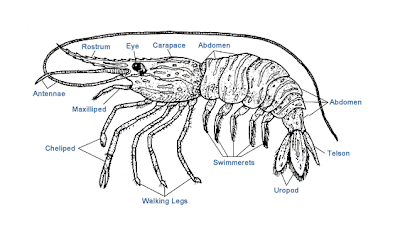I can never keep enough small snails in the aquarium. The crabs eat them; so do the big trophon snails. I'm always bringing home a few more, and always finding only one or two actually doing their work of keeping the walls and floor clean. The rest are reduced to empty shells lying on the sand, or new outfits for the hermits.
So when we went to Boundary Bay a few days ago, I planned to pick up a good handful of snails. The mud flats around Centennial Beach are loaded with them, starting a few steps below the high tide line. They're mostly the mud-flat snail, Batillaria attramentaria, spread so thickly that at every step I can hear the "crunch!" of a few more.
But this time, for variety, we went to the south end of Beach Grove and walked down to the US border. The tide was coming in, but there was still some flat sand. But no snails. Not one. There were clams in abundance, lying in groups on the sand at the edge of rocky patches. There were worm casts and worm tubes sticking up out of the sand. No crabs, no hermits, no snails.
Just a few metres north of the border, we passed two rotting logs buried deep in the sand. Here there were barnacles and crevasses packed with mussels and mudsnail shells.
 |
| Hollowed logs make great hideouts. |
 |
| Deep in a crack. |
I started collecting snails. Each one I picked up, I inspected; I didn't want any more hermit crabs. The aquarium held 11 at that point, more than enough for a small tank.
And each snail, as I turned it over to look for the glossy operculum, waved hermit pincers at me. I put them back on the log, and checked another. And another, and another ... They were all hermits. All around the first log, all around the second one, down the in the innards; hermits, hermits, hermits. Finally, I found 3 very small ones that seemed to have the right dark brown glossy lid on the opening; snails, at last. I dumped them in my bottle, with a few barnacles and mussels for the trophons to nibble on, and brought them home.
And once I'd left them a few minutes in a bowl, out crawled the hermits. Out of 3 "snails", I got 5 hermits. The last two were really tiny, and must have been hitchikers on the barnacle clumps.
The more I think about this, the stranger it seems. There were no snails to be seen in the vicinity of these stumps. And all the snail shells there housed hermits. Where did they get the shells? Why did I find no surviving snails?
Did the hermits invade a colony of snails and wipe out every single one for their shells? But hermits don't usually do that; they use empty shells, or take them away from other hermits. They ignore live snails.
So did something else, crabs maybe, kill the snails and leave them piled into the logs for the hermits? Where are the crabs, then? Why only on the logs?
Or did the hermits immigrate, shells and all, from far down the beach? Why? Why were there none scuttling across the sand, or under the nearby rocks?
 |
| Hermit, one of the 11. See how his shell is broken? That's how a crab gets at the tasty snail meat. |
I wish hermits could talk. We'll have to take another walk down that way next time the tide is a bit lower, to look for the missing snail population.
And now I have 16 hermits in my tank. At least the newest residents are tiny.
(More about these snails - before the hermits get them - om Dave Ingram's
Island Nature blog.)

